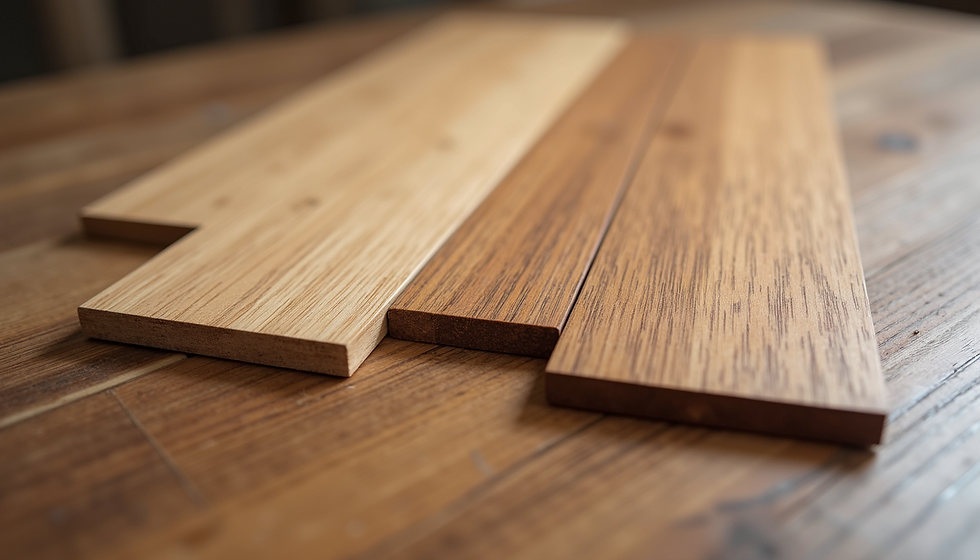Restore the Beauty of Your Hardwood Floors
- Peyton Moffitt
- Oct 13
- 4 min read
Hardwood floors add warmth and elegance to any home. Over time, however, they can lose their shine and develop scratches, dents, or discoloration. Restoring wood floors is a rewarding project that can bring back their original charm and increase the value of your home. Whether you want to tackle the job yourself or hire a professional, understanding the process and options available will help you make the best decision.
How to Restore Wood Floors: Essential Steps
Restoring wood floors involves several key steps to ensure a smooth, beautiful finish. Here’s a practical guide to help you get started:
Clean the Floor Thoroughly
Begin by removing all dust, dirt, and debris. Use a vacuum with a soft brush attachment and then mop with a wood floor cleaner. Avoid using water excessively as it can damage the wood.
Assess the Damage
Look for scratches, stains, or areas where the finish has worn away. Minor scratches can sometimes be fixed with a wood stain marker or a blending pencil. For deeper damage, sanding may be necessary.
Sand the Floor
Sanding removes the old finish and smooths out imperfections. Use a drum sander for large areas and an edge sander for corners. Start with coarse-grit sandpaper and gradually move to finer grits for a polished surface.
Clean Up Dust
After sanding, vacuum and wipe the floor with a tack cloth to remove all dust. This step is crucial for a flawless finish.
Apply Stain or Finish
Choose a stain color if you want to change or enhance the wood tone. Apply evenly with a brush or cloth. Once dry, apply a protective finish such as polyurethane to seal and protect the floor.
Allow Proper Drying Time
Follow the manufacturer’s instructions for drying times between coats. Usually, two to three coats of finish are recommended for durability.
Maintain Your Floors
Use rugs in high-traffic areas, avoid wearing shoes indoors, and clean regularly with appropriate products to keep your floors looking their best.

Why Restore Wood Floors Instead of Replacing Them?
Restoring wood floors is often a better choice than replacing them. Here are some reasons why:
Cost-Effective: Refinishing hardwood floors is usually less expensive than installing new flooring.
Preserves Original Character: Older hardwood floors have unique grains and patinas that add charm and history to your home.
Environmentally Friendly: Refinishing reduces waste by keeping existing materials in use.
Increases Home Value: Well-maintained hardwood floors are a strong selling point for potential buyers.
Less Disruption: Refinishing takes less time and causes less mess compared to a full replacement.
By choosing to restore wood floors, you save money and time while enhancing the beauty and longevity of your home’s flooring.

Is it worth refinishing hardwood floors?
Deciding whether to refinish your hardwood floors depends on several factors:
Condition of the Floor: If the wood is deeply scratched, stained, or warped, refinishing can restore its appearance. However, if the floorboards are severely damaged or rotting, replacement might be necessary.
Number of Previous Refinishes: Hardwood floors can typically be refinished 3-5 times before the wood becomes too thin.
Cost vs. Value: Refinishing is generally more affordable and adds value, but if the floor is in very poor condition, replacement could be a better investment.
Personal Preference: If you want to change the color or style of your floors, refinishing offers flexibility with stains and finishes.
For those unsure about the process, consulting a professional can provide clarity. They can assess your floors and recommend the best course of action.

Tips for Maintaining Restored Hardwood Floors
Once your floors are restored, proper care will keep them looking beautiful for years:
Use Furniture Pads: Place felt pads under furniture legs to prevent scratches.
Avoid Excess Moisture: Clean spills immediately and use a damp mop rather than soaking the floor.
Regular Cleaning: Sweep or vacuum regularly to remove dirt and grit that can scratch the surface.
Control Humidity: Wood expands and contracts with humidity changes. Use a humidifier or dehumidifier to maintain stable indoor conditions.
Refinish When Needed: Keep an eye on wear and consider refinishing again when the finish starts to dull or wear thin.
By following these simple tips, you can extend the life of your hardwood floors and enjoy their beauty for decades.
Professional Hardwood Floor Refinishing: When to Call the Experts
While DIY projects can be satisfying, some situations call for professional help. If your floors have extensive damage, uneven surfaces, or you want a flawless finish, hiring experts is a smart choice. Professionals have the right tools and experience to handle:
Deep scratches and gouges
Water damage repairs
Complex staining and finishing techniques
Large areas requiring efficient sanding
For reliable service, consider hardwood floor refinishing specialists who can restore your floors with precision and care. Their expertise ensures a durable, beautiful finish that enhances your home’s appeal.
Restoring your hardwood floors is a worthwhile investment that brings warmth and elegance back to your living space. With the right approach and maintenance, your floors will continue to impress for years to come.





Comments